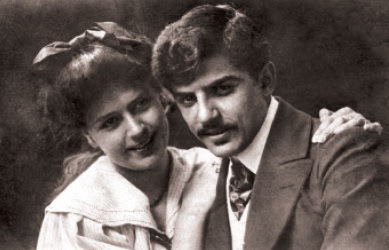Facebook reminded me of the attached. It is my reproduction of an article I posted in Keghart.com 10 years ago today. Vahe H Apelian
The award-winning novelist Chris Bohjalian wrote "The Sandcastle Girls" in 2002. The news of the novel's publication was enthusiastically anticipated and received by the Armenian community, even before it hit bookstore shelves.
A quarter-of-century before Sandcastle Girls, journalist and editor Antranig Dzarougian (Անդրանիկ Ծառուկեան) wrote a novel in Western Armenian titled “Love in the Yeghern - (Սէրը Եղեռնին Մէջ)”. Medz Yeghern is a term that the survivors of the Armenian Genocide coined to refer to the horrible reality of their dispossession, of their loss of loved ones and of property, and the loss of their millennia-old way of life on their ancestral lands.
Both novels are love stories. Sandcastle Girls is story within a story. Amazon.com describes with these words: “When Elizabeth Endicott arrives in Aleppo, Syria, she has a diploma from Mount Holyoke, a crash course in nursing, and only the most basic grasp of the Armenian language. It’s 1915, and Elizabeth has volunteered to help deliver food and medical aid to Armenian Genocide survivors. There she meets Armen, a young Armenian engineer who has already lost his wife and infant daughter. After leaving Aleppo and traveling to Egypt to join the British Army, he begins writing to Elizabeth, realizing that he has fallen in love with the wealthy young American.
Years later, their American granddaughter, Laura, embarks on a journey through her family history, uncovering a story of love, loss—and a wrenching secret that has been buried for generations.”
“Love in the Yeghern” is based on the love story of the eminent early 20th century Armenian poet Roupen Sevag, who was a medical doctor and an accomplished painter. The novel is a true depiction and a fictional rendering of their lives, interactions and stands vis-à-vis the cultural and political affairs of the Armenians in the Ottoman Empire. Most of the other characters in the book are also depictions of prominent Constantinople / Istanbul Armenians. The characters are referred to either by their first or family names. However, for anyone who has a basic knowledge of Western Armenian culture that blossomed after remaining dormant for centuries and hit its zenith just before the Genocide, it would not be difficult to surmise who Dzarougian refers to when he describes characters named Varoujan, Adom, Zartarian and many more.
Roupen Chilingirian Sevag was born in Silvri, Ottoman Empire on Feb. 15, 1885. After graduating from the famed Berberian Armenian School in Istanbul he went to Lausanne, Switzerland where he studied medicine and fell in love with a vibrant (German) woman named Yanni. The young couple, driven by Roupen's patriotism, returned to Istanbul in 1914. Their return home proved to be fatally fateful. Roupen was arrested at the onset of the Armenian Genocide on April 24, 1915 and was tortured to death on August 26, 1915 in Çankır (Chankir), Turkey along with poets Taniel Varoujan, Siamanto and others. He was 30-years-old.
Sevag is known for his patriotic and humanistic poetry. He is fondly remembered to this day. In 2011 Armenia issued a stamp in his honor. A Yerevan school is named after him. In 2012 a family museum, established and run by his nephew, was relocated from Nice, France to Holy Etchmiazin in Armenia.
Dzarougian depicts Sevag's wife and concludes the novel with these words (see note): “Janine wrote poetry in French and published them in books. One of her books received an award from the French Academy. She lived engrossed in her books and in her children Levon and Shamiram. With the passing years ashes covered her hair, but not her heart. Her heart remained fresh and vibrant defying time and the years with an indifference but always open, always graceful on white pages and in her thoughts with her Roupen…..”.
Kourken Mekhitarian noted in his review of Armenian literature that following his death Sevag had emerged as a tragic but iconic and heroic figure and that his life could be the subject of a captivating novel. Dzarougian’s novel Love in Yeghern makes for a captivating reading and makes justice to the young couple’s love story. The novel awaits translation into English and French on the eve of the centennial of the Armenian Genocide, the Medz Yeghern.
Note: It is claimed that Roupen's wife bitterly disappointed from the German government conduct, settled in France instead and refused to write in German. Their daughter Shamiram passed away in Nice at the ripe age of 102 in October 2016.
 |



No comments:
Post a Comment